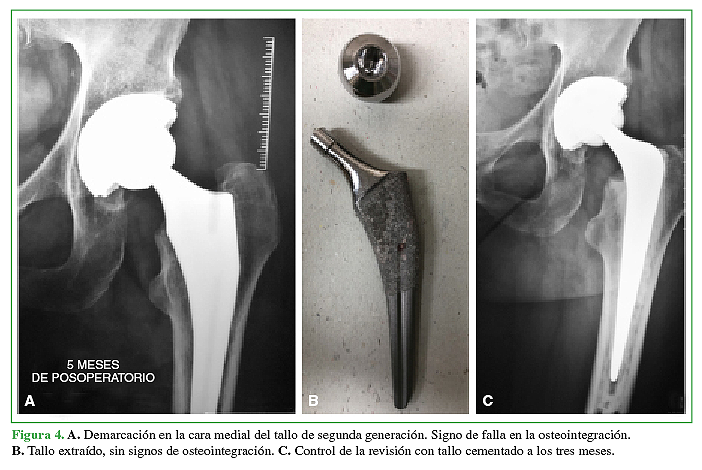Short-term outcomes in total hip arthroplasties using second-generation metaphyseal fixation stems
Main Article Content
Abstract
Level of Evidence: IV
Downloads
Metrics
Article Details
Manuscript acceptance by the Journal implies the simultaneous non-submission to any other journal or publishing house. The RAAOT is under the Licencia Creative Commnos Atribución-NoComercial-Compartir Obras Derivadas Igual 4.0 Internacional (CC-BY-NC.SA 4.0) (http://creativecommons.org/licences/by-nc-sa/4.0/deed.es). Articles can be shared, copied, distributed, modified, altered, transformed into a derivative work, executed and publicly communicated, provided a) the authors and the original publication (Journal, Publisher and URL) are mentioned, b) they are not used for commercial purposes, c) the same terms of the license are maintained.
In the event that the manuscript is approved for its next publication, the authors retain the copyright and will assign to the journal the rights of publication, edition, reproduction, distribution, exhibition and communication at a national and international level in the different databases. data, repositories and portals.
It is hereby stated that the mentioned manuscript has not been published and that it is not being printed in any other national or foreign journal.
The authors hereby accept the necessary modifications, suggested by the reviewers, in order to adapt the manuscript to the style and publication rules of this Journal.
References
2. Parvizi J, Keisu KS, Hozack WJ, Sharkey PF, Rothman RH. Primary total hip arthroplasty with an uncemented
femoral component: a long-term study of the taperloc stem. J Arthroplasty 2004;19(6):151-6.
https://doi.org/10.1016/j.arth.2003.10.003
3. Casper DS, Kim GK, Restrepo C, Parvizi J, Rothman RH. Primary total hip arthroplasty with an uncemented
femoral component. Five-to nine-year results. J Arthroplasty 2011;26(6):838-41. https://doi.org/10.1016/j.arth.2011.02.010
4. Hernández Cortes P, Nájera Sagastume OO, Mesa Ramos F, Pajares López M, Hernández Hernández MA.
Hydroxyapatite-coated stems with metaphyseal and diaphyseal press-fit. Eleven-year follow-up results. Acta Orthop Belg 2002;68(1):24-32. PMID: 11915455
5. Streit MR, Innmann MM, Merle C, Bruckner T, Aldinger PR, Gotterbam T. Long-term (20- to 25-year) results
of an uncemented tapered titanium femoral component and factors affecting survivorship. Clin Orthop Relat Res
2013;471(10):3262-9. https://doi.org/10.1007/s11999-013-3033-4
6. Pilliar RM, Lee JM, Maniatopoulos C. Observation on the effect of movement on bone ingrowth into poroussurfaced implants. Clin Orthop 1986;(208):108-13. PMID: 3720113
7. Capello WN, D´Antonio JA, Jaffe WL, Geesink RG, Manley MT Feinberg JR. Hydroxyapatite-coated femoral
components: 15-year minimum followup. Clin Orthop 2006;453:75-80. https://doi.org/10.1097/01.blo.0000246534.44629.b2
8. Hwang K-T, Kim Y-H, Kim Y-S, Choi I-Y. Total hip arthroplasty using cementless grit-blasted femoral component: a minimum 10-year follow-up study. J Arthroplasty 2012;27(8):1554-61. https://doi.org/10.1016/j.arth.2012.02.005
9. Dalton J, Cook SD, Thomas KA, Kay JF. The effect of operative fit and hydroxyapatite coating on the mechanical
and biological response to porous implants. J Bone Joint Surg Am 1995;77(1):97-110.
https://doi.org/10.2106/00004623-199501000-00012
10. Faizan A, Wuestemann T, Nevelos J, Bastian AC, Collopy D. Development and verification of a cementless novel tapered wedge stem for total hip arthroplasty. J Arthroplasty 2014;30(2):235-40.
https://doi.org/10.1016/j.arth.2014.09.023
11. Issa K, Pivec R, Wuestemann T, Tatevossian T, Nevelos J Mont MA. Radiographic fit and fill analysis of a
new second-generation proximally coated cementless stem compared to its predicate design. J Arthroplasty
2014;29(1):192-8. https://doi.org/10.1016/j.arth.2013.04.029
12. Colacchio N, Robbins C, Aghazadeh M, Talmo C, Bono J. Total hip intraoperative femur fracture: does a tapered wedge design with a size specific medial curvature reduce the incidence of intraoperative femur fracture? J Arthroplasty 2017;32(10):3163-8. https://doi.org/10.1016/j.arth.2017.05.012
13. Kolisek FR, Chughtai M, Mistry JB, Elmallah RK, Jaggard C, Malkani AL, et al. Outcomes of second-generation
tapered wedge femoral stem. Surg Technol Int 2016;28:275-9. PMID: 27042781
14. Cooper HJ, Rodríguez J. Early post-operative periprosthetic femur fracture in the presence of a non-cemented
tapered wedge femoral stem. HSS J 2010;6(2):150-4. https://doi.org/10.1007/s11420-010-9161-4

